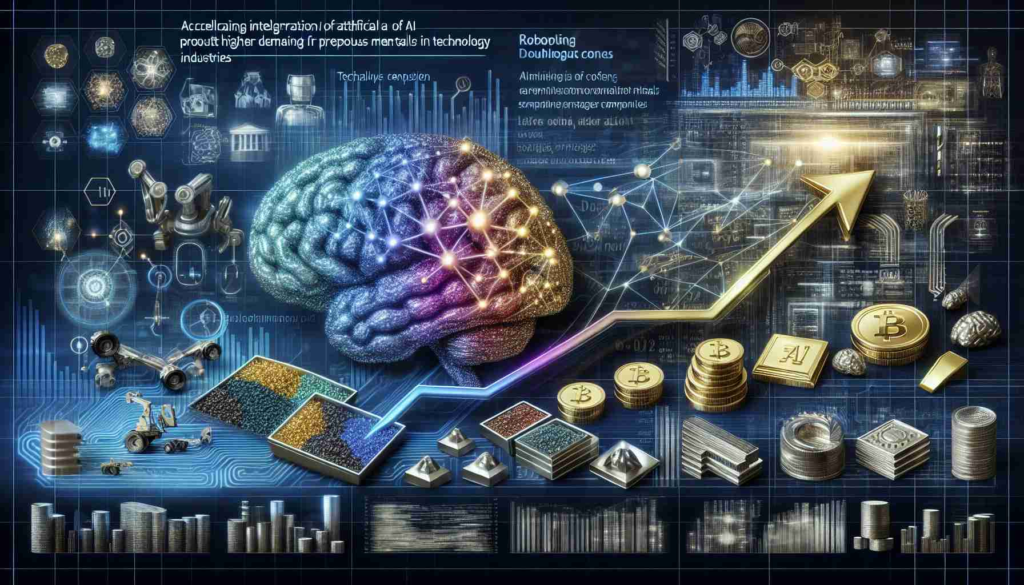
The recent upsurge in artificial intelligence (AI) technologies and their integration into various sectors such as cloud services, medical care, automotive assistance, and smart manufacturing, have been prolific and have significantly surpassed initial projections. This remarkable evolution in AI has led to a requisite growth in the construction of production lines, propelling the semiconductor and electronics industries due to the escalating demand for chip components and memory requirements.
With the semiconductor market’s previous challenges dissipating, a surge in electronic product supply is projected to catalyze market expansion. Not only is chip production for AI technologies on the rise, but the development of AI models demands extensive data sets, thus driving the need for larger memory capacities in electronic devices—anticipated to expand by 15 to 30 percent. Consequently, the necessitation of hard disks, drives, and even gold bonding wires is expected to increase.
As a response to these technological advancements, both private and public sectors are anticipated to foster upgrades within their data centers. Advancements in consumer electronics will likely result in an amplified need for sophisticated circuit boards, which in turn, will boost the requirement for gold plating. Furthermore, the silver market is presumed to extend its reach beyond photovoltaics, with applications in constructing power grids through devices like switches, relays, and capacitors.
This burgeoning demand for precious metals in the tech industry bodes well for mining companies. Sierra Madre Gold and Silver, with their noteworthy La Guitarra project in Mexico, alongside Victoria Gold, which celebrated an 11 percent increase in gold production at its Eagle gold mine in the Yukon, are prime examples of industry stakeholders benefiting from these trends.
**Summary**: The rapid integration and advancements in AI technologies are driving significant demand for semiconductor components, memory capacities, and consequently, precious metals, propelling industries such as gold and silver mining. Companies such as Sierra Madre Gold and Silver and Victoria Gold are already capitalizing on this market growth.
Industry Overview and Market Forecasts
The Artificial Intelligence (AI) industry is rapidly transforming the global markets by integrating AI technologies across multiple sectors such as health care, automotive, cloud computing, and smart manufacturing. The AI realm not only requires advanced algorithms and machine learning models but also necessitates powerful hardware to support its complex computations. This hardware typically includes high-performance semiconductors and memory storage devices, which are critical components in running AI technologies efficiently.
According to industry analyses, the semiconductor market is witnessing a recovery from past challenges and is poised for further expansion due to the increased manufacture of electronic products with AI capabilities. As AI continues to evolve, it necessitates robust chipsets and larger memory storage, which in turn boosts the semiconductor and electronics industries. Market forecasts suggest that the semiconductor industry is set to see significant growth, estimated to increase by 15 to 30 percent in the demand for memory capacity in electronic devices.
Moreover, with technology advancements, there is a growing tendency for both private and public sectors to invest in upgrading their data center infrastructures to accommodate the high-performance computing requisites of AI. These upgrades often require more advanced circuit boards and therefore, a higher consumption of precious metals like silver and gold, for components such as gold bonding wires and gold plating on circuitry.
Issues Related to the Industry or Product
The rapid growth of this sector is not without its challenges. One key issue facing the semiconductor industry is the complexity of the supply chain and the need for consistent innovation to keep up with AI’s exponential growth. Additionally, the industry must manage the environmental impact of increased mining activities for precious metals, ensuring sustainable and ethical sourcing methods.
Another challenge is the cyclical nature of the semiconductor market, with demand sometimes outpacing supply and creating bottlenecks that can hinder the growth of AI technologies. Moreover, geopolitical tensions can impact the availability and cost of materials, which in turn can affect the stability of the semiconductor industry.
The increased reliance on semiconductors and memory storage presents its own set of challenges, such as concerns about data security and the rise of cyber threats that could potentially harm vast amounts of stored data or disrupt AI systems.
For industry stakeholders and those looking to invest in these booming markets, leading sources of market analysis and insights such as Bloomberg or Reuters provide valuable information necessary for informed decision-making. These links serve as gateways to the dynamic world of market trends and industry reports.
Summary
In light of the rapid advancement and integration of AI technologies, there is an escalating demand for advanced semiconductor components, increased memory capacities, and consequently, precious metals. This demand is triggering significant growth in related industries, including gold and silver mining, with companies like Sierra Madre Gold and Silver and Victoria Gold standing as notable beneficiaries. These industry developments underscore the interconnectivity between the AI sector’s evolution and the broader economic impact on related markets and resources.

Marcin Frąckiewicz is a renowned author and blogger, specializing in satellite communication and artificial intelligence. His insightful articles delve into the intricacies of these fields, offering readers a deep understanding of complex technological concepts. His work is known for its clarity and thoroughness.

